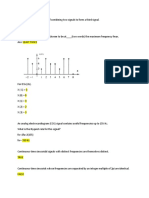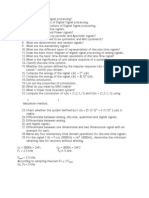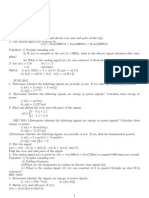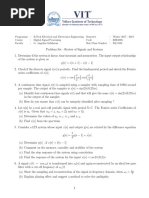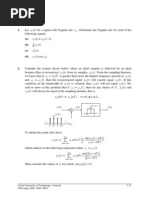DSP Assignments
Uploaded by
Mohit GoelDSP Assignments
Uploaded by
Mohit Goel1. If the input signal is x(t)= sin200t and signal is sampled at Nyquist rate.
Can we recover the original signals from the samples. If No, give the reason. 2. Consider the analog signal x(t)= 3 cos 2000t + 5 sin 6000t + 10cos 12000t (a) What is the nyquist rate for the signal? (b) Assume if the signal are sampled at sampling rate Fs= 5000sample/sec. What is the discrete time system obtained after sampling? (c) What is the analog signal we can reconstruct from samples if we use ideal interpolation? 3. Find signal are periodic or not? (a) X(t) = 3 cos 200t (b) X(n)= 3 cos 200n (c) X(t)= 3 cos200t+ 2cos 200t (d) X(t)= cos(200t). cos (200t) (e) X(n)= 3 cos200n+ 2cos 200n (f) X(n)= cos(200n). cos (200n) (g) X(n)= ej(4n + /6) 4. What is the difference between discrete and digital signal? 5. A discrete time system can be (a) Static or dynamic (b) Linear or Non-Linear (c) Time Invariant or Time variant (d) causal or non causal (e) Stable or Unstable Examine the following system with respect to above properties I. Y(n)= cos[x(n)] II. III. IV. V. VI. VII. Y(n) =
k =
x(k )
n +1
Y(n)= x(n) cos(w0n) Y(n) = x(n) Y(n)= x(-n) Y(n)= 3x(n)+4 Y(n) = x ( n )
VIII. Y(n)= x(2n) 6. Find even and odd part of signal
x ( n ) = {2, 3, 4, 5, 6}
7. A digital communication link carries binary coded words representing samples of an input signal x(t) = 3 cos 600t + 2 cos 1800t The link is operated at 10000bits/sec and each input sample is quantized into 1024 different levels. (a) What is the sampling frequency and folding frequency? (b) What is the Nyquist rate for the signal x(t). (c) Write expression for discrete signal obtained. (d) What is the resolution? 8. Find the convolution of two signal x(n) = u(n) and h(n) = an u(n) 9. Find out that unit impulse signal is energy signal or a power signal? 10. X(n) = {2, 3, 5, 7}
Resolve the sequence into a sum of weighted impulse sequences?
You might also like
- Ec010403 Signals and Systems Questionbank PDFNo ratings yetEc010403 Signals and Systems Questionbank PDF16 pages
- JNTUK_3_2_1st_mid_Digital_Signal_Processing_R2032043_online_bitsNo ratings yetJNTUK_3_2_1st_mid_Digital_Signal_Processing_R2032043_online_bits8 pages
- Department of Electrical Engineering Mid-Semester Examination, 2021 (Spring) Program: B. Tech. 5 SemesterNo ratings yetDepartment of Electrical Engineering Mid-Semester Examination, 2021 (Spring) Program: B. Tech. 5 Semester3 pages
- Fall Semester 2019-20 ECE4001 Digital Communication Systems Digital Assignment 1 Due Date: 09/09/2019No ratings yetFall Semester 2019-20 ECE4001 Digital Communication Systems Digital Assignment 1 Due Date: 09/09/20194 pages
- Fall Semester 2019-20 ECE4001 Digital Communication Systems Digital Assignment 1 Due Date: 09/09/2019No ratings yetFall Semester 2019-20 ECE4001 Digital Communication Systems Digital Assignment 1 Due Date: 09/09/20194 pages
- Mumbai University Signals and Systems University QuestionsNo ratings yetMumbai University Signals and Systems University Questions2 pages
- Eee518 Digital Signal Processing Quiz Bank To CatNo ratings yetEee518 Digital Signal Processing Quiz Bank To Cat4 pages
- Department of Computer Engineering: x n π n R m)No ratings yetDepartment of Computer Engineering: x n π n R m)3 pages
- Analog Signal Processing Tutorial 2: Sampling and ReconstructionNo ratings yetAnalog Signal Processing Tutorial 2: Sampling and Reconstruction12 pages
- 6.1 Sampling and Reconstruction of Analog Signals: Piyush Kumar 20104148901 G.E.C, KaimurNo ratings yet6.1 Sampling and Reconstruction of Analog Signals: Piyush Kumar 20104148901 G.E.C, Kaimur9 pages
- Unit - Iii Signal Transmission Through Linear SystemsNo ratings yetUnit - Iii Signal Transmission Through Linear Systems3 pages
- Haramaya Inistitute of Technology School of Electrical and Computer Engineering Signal and Systems Analysis WorksheetNo ratings yetHaramaya Inistitute of Technology School of Electrical and Computer Engineering Signal and Systems Analysis Worksheet5 pages
- Digital Signal and Image Processing using MATLAB, Volume 3: Advances and Applications, The Stochastic CaseFrom EverandDigital Signal and Image Processing using MATLAB, Volume 3: Advances and Applications, The Stochastic Case3/5 (1)
- Student Solutions Manual to Accompany Economic Dynamics in Discrete Time, secondeditionFrom EverandStudent Solutions Manual to Accompany Economic Dynamics in Discrete Time, secondedition4.5/5 (2)
- Feedback Amplifier: By: Mohit Goel (Mohit Goel)No ratings yetFeedback Amplifier: By: Mohit Goel (Mohit Goel)45 pages
- (D) Power Amplifier Converts A Part of DC Power Into Ac Output PowerNo ratings yet(D) Power Amplifier Converts A Part of DC Power Into Ac Output Power6 pages
- Digital Image Processing Question Answer Bank90% (72)Digital Image Processing Question Answer Bank69 pages
- Phoneme Classification Chart Phoneme Classification Chart Phoneme Classification Chart Phoneme Classification Chart100% (2)Phoneme Classification Chart Phoneme Classification Chart Phoneme Classification Chart Phoneme Classification Chart17 pages
- Prepared & Delivered By: Mohit Goel ID-16907No ratings yetPrepared & Delivered By: Mohit Goel ID-169077 pages
- A RSA - DWT Based Visual Cryptographic Steganogrphy TechniqueNo ratings yetA RSA - DWT Based Visual Cryptographic Steganogrphy Technique5 pages

